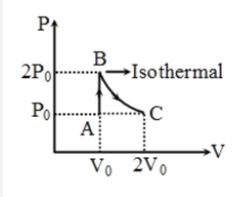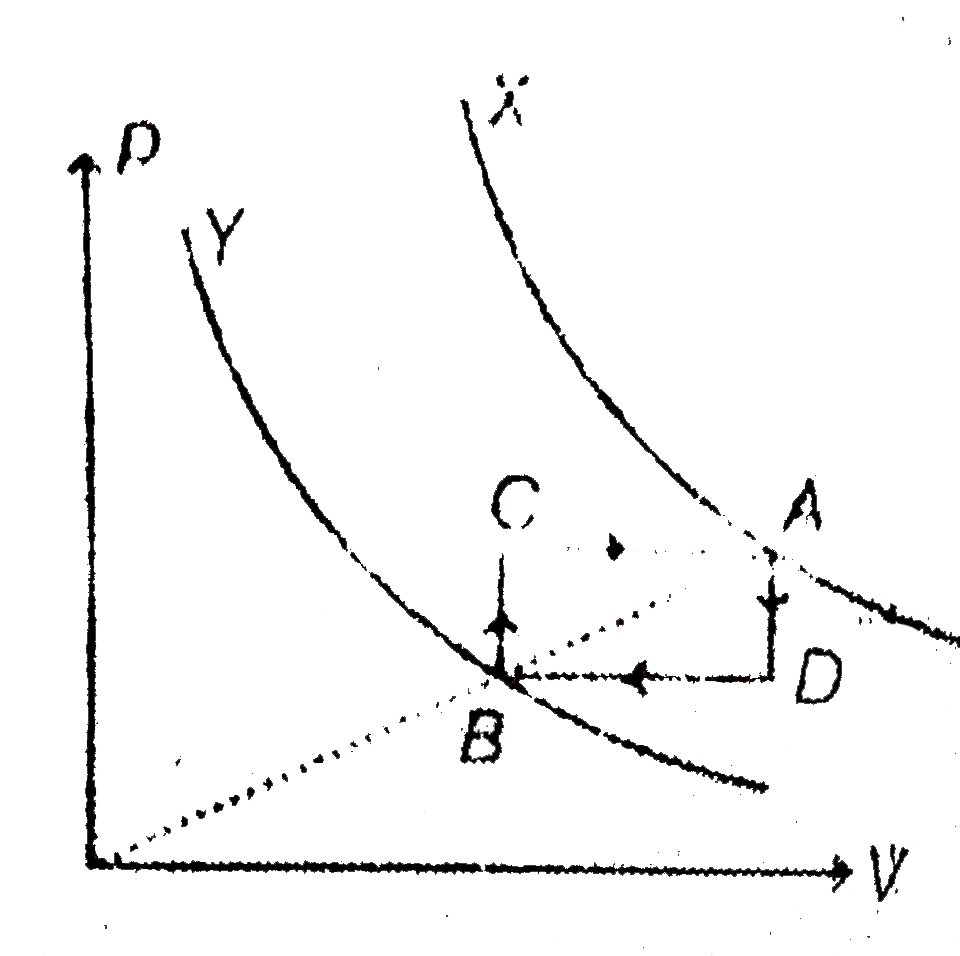When the gas is ideal and process is isothermal, then
P1V1=P2V2
ΔU=0
ΔW=0
ΔH1=ΔH2
The correct Answer is:A, B, D
To solve the question regarding the behavior of an ideal gas during an isothermal process, we can follow these steps:
Step 1: Understand the Ideal Gas Law
The ideal gas law is given by the equation:
PV=nRT
where:
- P = pressure
- V = volume
- n = number of moles of the gas
- R = universal gas constant
- T = absolute temperature
Step 2: Define Isothermal Process
An isothermal process is one where the temperature remains constant. Therefore, the change in temperature (ΔT) is zero:
ΔT=0
Step 3: Analyze the Implications of Isothermal Conditions
Since T is constant and n (number of moles) is constant, the product PV must also remain constant. Thus, we can express this as:
P1V1=P2V2
This confirms that the first option is correct.
Step 4: Calculate Change in Internal Energy (ΔU)
The change in internal energy for an ideal gas is given by:
ΔU=nCVΔT
Since ΔT=0:
ΔU=nCV×0=0
Thus, the second option is also correct.
Step 5: Analyze Work Done (ΔW)
The work done in a thermodynamic process can be related to the change in internal energy and enthalpy. According to the first law of thermodynamics:
ΔU=ΔH−ΔW
Given that ΔU=0:
0=ΔH−ΔW
This implies:
ΔW=ΔH
Thus, the work done is not zero, making the third option incorrect.
Step 6: Analyze Change in Enthalpy (ΔH)
The change in enthalpy is given by:
ΔH=nCPΔT
Since ΔT=0:
ΔH=nCP×0=0
This means:
ΔH2−ΔH1=0
or:
ΔH2=ΔH1
Thus, the fourth option is correct.
Conclusion
The correct options are:
- Option 1: Correct
- Option 2: Correct
- Option 3: Incorrect
- Option 4: Correct
Summary of Correct Options
The correct options are 1, 2, and 4.
---
The ideal gas law is given by the equation:
PV=nRT
where:
- P = pressure
- V = volume
- n = number of moles of the gas
- R = universal gas constant
- T = absolute temperature
An isothermal process is one where the temperature remains constant. Therefore, the change in temperature (ΔT) is zero:
ΔT=0
Since T is constant and n (number of moles) is constant, the product PV must also remain constant. Thus, we can express this as:
P1V1=P2V2
This confirms that the first option is correct.
The change in internal energy for an ideal gas is given by:
ΔU=nCVΔT
Since ΔT=0:
ΔU=nCV×0=0
Thus, the second option is also correct.
The work done in a thermodynamic process can be related to the change in internal energy and enthalpy. According to the first law of thermodynamics:
ΔU=ΔH−ΔW
Given that ΔU=0:
0=ΔH−ΔW
This implies:
ΔW=ΔH
Thus, the work done is not zero, making the third option incorrect.
The change in enthalpy is given by:
ΔH=nCPΔT
Since ΔT=0:
ΔH=nCP×0=0
This means:
ΔH2−ΔH1=0
or:
ΔH2=ΔH1
Thus, the fourth option is correct.
The correct options are:
- Option 1: Correct
- Option 2: Correct
- Option 3: Incorrect
- Option 4: Correct
The correct options are 1, 2, and 4.
Topper's Solved these Questions
- THERMODYNAMICSBOOK - AAKASH INSTITUTE ENGLISHCHAPTER - THERMODYNAMICSEXERCISE - SECTION-D
9 Videos
- THERMODYNAMICSBOOK - AAKASH INSTITUTE ENGLISHCHAPTER - THERMODYNAMICSEXERCISE - SECTION-E
10 Videos
- THERMODYNAMICSBOOK - AAKASH INSTITUTE ENGLISHCHAPTER - THERMODYNAMICSEXERCISE - SECTION-B
20 Videos
- THE SOLID STATE BOOK - AAKASH INSTITUTE ENGLISHCHAPTER - THE SOLID STATE EXERCISE - Assignment (SECTION - D) (ASSERTION-REASON TYPE QUESTION)
20 Videos
Similar Questions
When an ideal gas is compressed isothermally then its pressure increase because:
View Solution
An ideal gas undergoes a cyclic process, in which one process is isochoric, one process is isothermal and one process is adiabatic. During the isothermal process, 40 J heat is released by the gas, and during the isochoric process, 80 J heat is absorbed by the gas. if work done by the gas during adiabatic process is W1 and during isothermal process is W2 then the magnitude of W1W2 will be equal to:
View Solution
Knowledge Check
An ideal gas system undergoes an isothermal process, then the work done during the process is
AnRTln(V2V1)BnRTln(V1V2)C2nRTln(V2V1)D2nRTln(V1V2)
For an isothermal process
View SolutionAssertion: For an ideal gas in a cyclic process and in an isothermal process change in internal energy is zero.
Reason: In both processes there is no change in temperature.
View SolutionCalculate the workdone taking place when an ideal gas undergoes isothermal expansion.
View SolutionAn ideal diatomic gas undergoes a thermodynamic process as shown in the P−V diagram. The process AB is isochoric while the process BC is isothermal. The total heat gein to the gas in the process is nearly (use ln2=0.7)

View SolutionOne mole of an ideal monoatomic gas undergoes a cyclic process as shown in figure . Temperature at point 1 =300K and process 2−3 is isothermal .
_S01_113_O01.png) .
.
Net work done by gas in complete cycle is
View SolutionAn ideal monoatomic gas of one mole undergoes a cyclic process ADBCA as shown in figure. X and Y are two isothermal curves at temperature 211∘C and 127∘C respectively. If the work done by the gas in cyclic process is λR, then find the value of λ. (R is the gas constant)

View SolutionIn an isothermal process
View Solution
